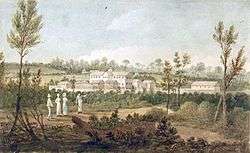Parramatta Female Factory
 Female penitentiary or factory, Parramata, watercolour; 15.9 x 25.7 cm. | |
| Location | Cumberland Hospital, North Parramatta, New South Wales |
|---|---|
| Coordinates | 33°48′03″S 151°00′00″E / 33.8009°S 151.0°ECoordinates: 33°48′03″S 151°00′00″E / 33.8009°S 151.0°E |
| Status | Register of the National Estate |
| Security class | Former female factory |
| Capacity | 1,230 |
| Opened | 1821 |
| Closed | 1848 |
| Managed by | NSW Health |
| Website |
www |
The Parramatta Female Factory, in the former penal colony of New South Wales, is located in the grounds of Cumberland Hospital, North Parramatta, New South Wales. It was one of 13 female factories in the colonies of New South Wales and Van Diemen's Land. In New South Wales, female factories were also established in Bathurst, Newcastle, Port Macquarie and Moreton Bay (2 factories). The factory idea was a combination of the functions of the British bridewells, prisons and workhouses.
History
The first female factory was above the Parramatta Gaol, in what is now Prince Alfred Square[1] (formerly known as Gaol Green and Hanging Green). This two storey building was commissioned by Governor King and the convict women moved in in 1804. Within a decade there was considerable pressure on the authorities to deal with increasing numbers of female convicts who could not be adequately accommodated at the factory. There were over 200 women and children in a place that could only house 30 at night.
The factory was the destination for many of the convict women sent as prisoners to the colony of NSW. Over 9,000 names have been recorded as passing through the factories, of which an estimated 5,000 went through Parramatta.[2]
With the arrival of Governor Lachlan Macquarie a solution was acted on. Macquarie selected a 4-acre (16,000 m2) portion of William Bligh's 105 acre grant further upstream on the Parramatta River to build a new factory and issued instructions to convict architect Francis Greenway to design a building that would accommodate 250 women. This was the first purpose built female factory in the Colony and a model for the others.
The first stone was laid by Governor Macquarie in 1818 and the women were transferred from the old factory in 1821.[3] The factory was built using convict labour from locally quarried sandstone and was completed in 1821[4] at the cost of £4,778. The walls of the main building ranged from 2 feet 6 inches (0.76 m) at the foundation to 20 inches (510 mm) at the apex of its three storeys. It had an oak shingled roof, floors of 6 inches (150 mm) paving or stringbark with barred leadlight windows in the basement and lead glazed windows on the upper floors. The first floor was used for meals with the top two floors for sleeping and other activities. The porter, deputy superintendent, superintendent and matron were provided with separate accommodation on the site.
The Parramatta Female Factory was multi-purpose. It was a place of assignment, a hospital, a marriage bureau, a factory, an asylum and a prison for those who committed a crime in the Colony. The reason it is called a factory is because it manufactured cloth - linen, wool and linsey woolsey. It was also the site of the colony's first manufactured export producing 60,000 yards (55,000 m) of woven cloth in 1822.The women also did spinning, knitting, straw plaiting, washing, cleaning duties and if in third class, rock breaking and oakum picking.[5]
In 1827, the factory was the site of Australia's first industrial action when women rioted as a response to a cut in rations and poor conditions. By 1842 the factory accommodated 1,203 women as well as children. With the end of convict transportation to the colony, in 1848 the site was reassigned as a Convict Lunatic and Invalid Asylum.
Current use
The Parramatta Female Factory is now the earliest surviving female factory in Australia. It forms part of the Cumberland Hospital and NSW Institute of Psychiatry. The site is listed on the New South Wales State Heritage Register.[6][7]
In popular culture
In 1937, Parramatta Female Factory was the subject of the film To New Shores directed by Douglas Sirk and starring Zarah Leander. Joy Storey wrote a musical about the female factory in the 1960s. Nick Enright wrote a play called the Female Factory in the 1980s. In 1981, Australian folk group Redgum released a track, "Parramatta Gaol 1843", with lyrics alluding to an escape attempt from the Parramatta Female Factory. In 2008 it was the subject of a play, a cartoon, an exhibition that travelled around Australia - Women Transported - Life in Australia's Convict Female Factories.
See also
References
- ↑ Geographical Names Board of NSW -http://www.gnb.nsw.gov.au/place_naming/placename_search/extract?id=ujjtBKrXMn
- ↑ https://sites.google.com/site/convictfemalefactories/
- ↑ https://sites.google.com/site/convictfemalefactories/
- ↑ "Government and General Orders". The Sydney Gazette and New South Wales Advertiser. 27 January 1821. p. 1.
- ↑ https://sites.google.com/site/convictfemalefactories/
- ↑ "Cumberland District Hospital Group". New South Wales State Heritage Register. Office of Environment and Heritage. Retrieved 6 May 2012.
- ↑ "Cumberland Hospital Heritage Precinct". New South Wales State Heritage Register. Office of Environment and Heritage. Retrieved 12 October 2017.
Further reading
3. Gay Hendriksen, Carol Liston and Trudy Cowley, Women Transported - Life in Australia's Convict Female Factories, 2008, Parramatta, Parramatta Heritage Centre
External links
- The Female Factory Online
- https://sites.google.com/site/convictfemalefactories/
- Parramatta Female Factory Precinct website
- Parramatta Female Factory Action Group Inc website
- Cascades Female Factory website
- Early images of the Female Factory
- Image of the Female penitentiary or factory, Parramatta, painted by Augustus Earle in 1826, from the National Archives of Australia.
- Michaela Ann Cameron (2015). "Parramatta Female Factory". Dictionary of Sydney. Dictionary of Sydney Trust. Retrieved 11 October 2015. [CC-By-SA]